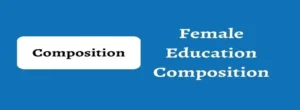Female Education: A Pathway to Empowerment and Progress
Introduction
Female education is an essential component of societal development and empowerment. It encompasses the various stages of formal and informal learning that girls and women engage in, from primary education to higher education and vocational training. Despite significant progress over the past century, numerous challenges still impede women’s access to quality education worldwide. This composition explores the importance of female education, the obstacles it faces, and the transformative impact it can have on individuals and communities.

The Importance of Female Education
Empowerment and Equality
Education is a fundamental human right and a powerful tool for empowerment. Educated women are more likely to participate in decision-making processes at home and in their communities, thereby promoting gender equality. By gaining knowledge and skills, women can challenge discriminatory practices, assert their rights, and seek opportunities for personal and professional growth.
Economic Benefits
Educated women contribute significantly to economic development. They are more likely to enter the workforce, earn higher incomes, and support their families financially. Studies show that when women are educated, they invest more in their children’s health, nutrition, and education, creating a positive ripple effect across generations. Educating girls also leads to a more skilled and diversified labor force, which is crucial for national economic progress.
Health and Well-being
Education plays a crucial role in improving health outcomes for women and their families. Educated women are more likely to understand and adopt healthy practices, seek medical care when needed, and make informed decisions about family planning. This leads to lower maternal and infant mortality rates, better nutritional standards, and overall improved family health.
Challenges to Female Education
Cultural and Societal Barriers
In many parts of the world, cultural norms and societal expectations restrict girls’ access to education. Traditional gender roles often prioritize domestic responsibilities over schooling for girls. Early marriage and childbearing further disrupt educational opportunities, as young brides are typically expected to focus on household duties rather than continue their studies.
Economic Constraints
Financial barriers are a significant obstacle to female education. In impoverished communities, families may prioritize boys’ education over girls’ due to limited resources. The cost of school fees, uniforms, books, and transportation can be prohibitive for many families. Additionally, girls often have to contribute to household income through labor, leaving little time for education.
Safety and Security Concerns
Safety concerns, including harassment and violence, deter many girls from attending school. In conflict-affected regions, schools may be targeted, making education a dangerous pursuit. The lack of safe and adequate sanitation facilities in schools also impacts girls’ attendance, particularly during menstruation.
Quality of Education
Even when girls have access to education, the quality of that education can be lacking. Inadequate infrastructure, poorly trained teachers, and insufficient learning materials compromise the educational experience. Gender biases in curricula and teaching methods further hinder girls’ academic achievements and self-confidence.
Strategies to Promote Female Education
Policy Interventions
Governments play a crucial role in promoting female education through policy interventions. Enacting laws that mandate free and compulsory education for all children, regardless of gender, is a fundamental step. Additionally, policies that address child marriage and protect girls’ rights to education are essential.
Financial Support
Providing financial support to families can alleviate the economic burden of educating girls. Scholarships, grants, and conditional cash transfers encourage families to prioritize girls’ education. Investing in school infrastructure, such as building safe and sanitary facilities, also supports girls’ attendance and retention.
Community Engagement
Engaging communities in promoting female education is vital. Community leaders, parents, and educators need to advocate for the value of educating girls. Awareness campaigns and community-based programs can challenge traditional gender norms and highlight the benefits of female education for the entire community.
Improving School Environments
Creating a safe and supportive school environment is essential for girls’ education. Implementing anti-bullying policies, ensuring safe transportation, and providing adequate sanitation facilities can significantly improve girls’ attendance and performance. Additionally, training teachers to recognize and address gender biases in the classroom fosters a more inclusive educational experience.
The Transformative Impact of Female Education
Individual Empowerment
Education transforms the lives of individual women by providing them with the skills and knowledge necessary to pursue their goals and aspirations. Educated women are more likely to have control over their lives, make informed decisions, and contribute to their communities in meaningful ways. They become role models for future generations, inspiring more girls to seek education.
Societal Progress
The benefits of female education extend beyond individuals to society as a whole. Educated women are better equipped to participate in the workforce, leading to economic growth and development. They also contribute to social progress by advocating for gender equality, human rights, and sustainable development. Societies that invest in female education tend to be more inclusive, equitable, and prosperous.
Global Development
On a global scale, female education is critical for achieving sustainable development goals (SDGs). Goals related to poverty eradication, health, gender equality, and economic growth are all closely linked to the education of girls and women. By investing in female education, countries can accelerate progress towards these goals and create a more just and equitable world.
Conclusion
Female education is a cornerstone of development and empowerment. Despite the numerous challenges that girls and women face in accessing quality education, the benefits are undeniable and far-reaching. Empowering women through education leads to healthier families, stronger economies, and more equitable societies. It is imperative that governments, communities, and international organizations continue to prioritize and invest in female education, ensuring that every girl has the opportunity to learn, grow, and contribute to her fullest potential. By doing so, we can pave the way for a brighter, more inclusive future for all.
